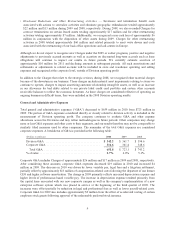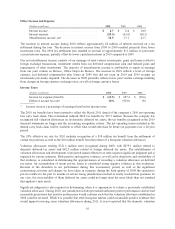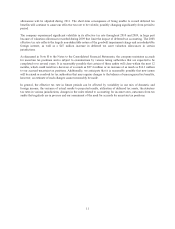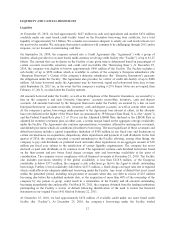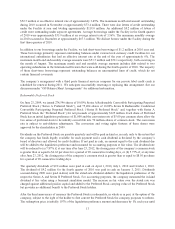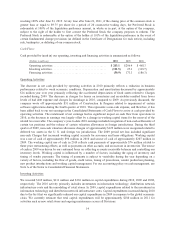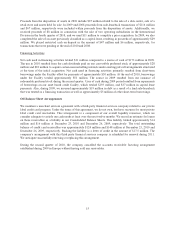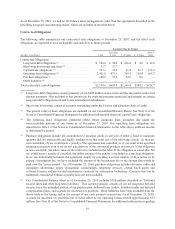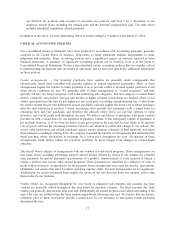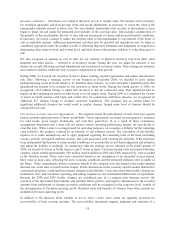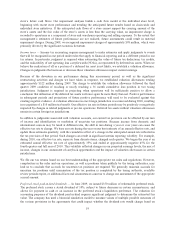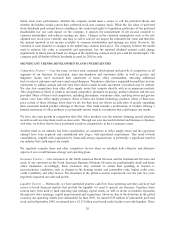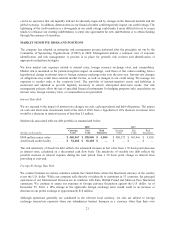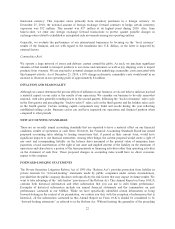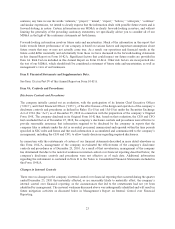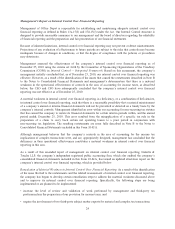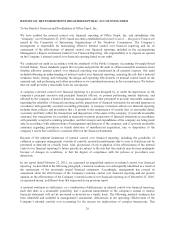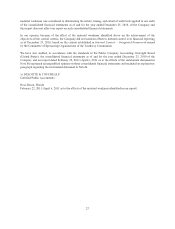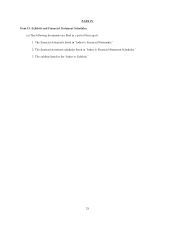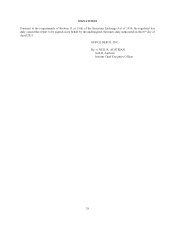Office Depot 2010 Annual Report Download - page 20
Download and view the complete annual report
Please find page 20 of the 2010 Office Depot annual report below. You can navigate through the pages in the report by either clicking on the pages listed below, or by using the keyword search tool below to find specific information within the annual report.store’s future cash flows. Our impairment analysis builds a cash flow model at the individual store level,
beginning with recent store performance and trending the anticipated future results based on chain-wide and
individual store initiatives. If the anticipated cash flows of a store cannot support the carrying amount of the
store’s assets and the fair value of the store’s assets is less than the carrying value, an impairment charge is
recorded to operations as a component of store and warehouse operating and selling expenses. To the extent that
management’s estimates of future performance are not realized, future assessments could result in material
impairment charges. During 2008, we recognized impairment charges of approximately $98 million, which were
primarily driven by the significant economic downturn.
Income taxes — Income tax accounting requires management to make estimates and apply judgments to events
that will be recognized in one period under rules that apply to financial reporting and in a different period in our
tax returns. In particular, judgment is required when estimating the value of future tax deductions, tax credits,
and the realizability of net operating loss carryforwards (NOLs), as represented by deferred tax assets. When we
believe the realization of all or a portion of a deferred tax asset is not likely, we establish a valuation allowance.
Changes in judgments that increase or decrease these valuation allowances impact current earnings.
Because of the downturn in our performance during this recessionary period, as well as the significant
restructuring activities and charges we have taken in response, we established valuation allowances totaling
approximately $322 million during 2009. The charge to establish the valuation allowance followed the third
quarter 2009 condition of reaching or nearly reaching a 36 month cumulative loss position in two taxing
jurisdictions. Judgment is required in projecting when operations will be sufficiently positive to allow a
conclusion that utilization of the deferred tax assets will once again be more likely than not. Positive performance
in subsequent periods and projections of future positive performance will need to be evaluated against this
existing negative evidence. A valuation allowance in one foreign jurisdiction was removed during 2010, resulting
in recognition of a $10 million tax benefit. Our effective tax rate in future periods may be positively or negatively
impacted by changes in related judgments or pre-tax operations. Deferred tax assets without valuation allowances
remain in certain foreign tax jurisdictions.
In addition to judgments associated with valuation accounts, our current tax provision can be affected by our mix
of income and identification or resolution of uncertain tax positions. Because income from domestic and
international sources may be taxed at different rates, the shift in mix during a year or over years can cause the
effective tax rate to change. We base our rate during the year on our best estimate of an annual effective rate, and
update those estimates quarterly, with the cumulative effect of a change in the anticipated annual rate reflected in
the tax provision of that period. Such changes can result in significant interim reporting volatility. For example,
during 2010, our effective tax rate, separate from discrete items, changed each quarter. We began the year at an
estimated annual effective tax rate of approximately 35% and ended at approximately negative 45% for the
fourth quarter and full year of 2010. This volatility reflected changes in our projected earnings levels, the mix of
income, changes in our assessment of carryback opportunities and the impact of valuation allowances in certain
jurisdictions.
We file our tax returns based on our best understanding of the appropriate tax rules and regulations. However,
complexities in the rules and our operations, as well as positions taken publicly by the taxing authorities, may
lead us to conclude that accruals for uncertain tax positions are required. We generally maintain accruals for
uncertain tax positions until examination of the tax position is completed by the taxing authority, available
review periods expire, or additional facts and circumstances cause us to change our assessment of the appropriate
accrual amount.
Preferred stock paid-in-kind dividends — In June 2009, we issued $350 million of redeemable preferred stock.
The preferred stock carries a stated dividend of 10%, subject to future decreases in certain circumstances, and
allows for payment in cash or an increase in the preferred stock’s liquidation preference. The valuation for
accounting purposes of the dividend paid in-kind requires significant judgment to determine the estimated fair
value. The company has used a binomial simulation model to measure values of multiple possible outcomes of
the various provisions in the agreements that could impact whether the dividend rate would change based on
19


